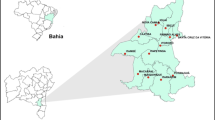Abstract
Background, Goal and Scope
System expansion is a method used to avoid co-product allocation. Up to this point in time it has seldom been used in LCA studies of food products, although food production systems often are characterised by closely interlinked sub-systems. One of the most important allocation problems that occurs in LCAs of agricultural products is the question of how to handle the co-product beef from milk production since almost half of the beef production in the EU is derived from co-products from the dairy sector. The purpose of this paper is to compare different methods of handling co-products when dividing the environmental burden of the milk production system between milk and the co-products meat and surplus calves.
Main Features
This article presents results from an LCA of organic milk production in which different methods of handling the co-products are examined. The comparison of different methods of co-product handling is based on a Swedish LCA case study of milk production where economic allocation between milk and meat was initially used. Allocation of the co-products meat and surplus calves was avoided by expanding the milk system. LCA data were collected from another case study where the alternative way of producing meat was analysed, i.e. using a beef cow that produces one calf per annum to be raised for one and a half year. The LCA of beef production was included in the milk system. A discussion is conducted focussing on the importance of modelling and analysing milk and beef production in an integrated way when foreseeing and planning the environmental consequences of manipulating milk and beef production systems.
Results
This study shows that economic allocation between milk and beef favours the product beef. When system expansion is performed, the environmental benefits of milk production due to its co-products of surplus calves and meat become obvious. This is especially connected to the impact categories that describe the potential environmental burden of biogenic emissions such as methane and ammonia and nitrogen losses due to land use and its fertilising. The reason for this is that beef production in combination with milk can be carried out with fewer animals than in sole beef production systems.
Conclusion, Recommendation and Perspective
Milk and beef production systems are closely connected. Changes in milk production systems will cause alterations in beef production systems. It is concluded that in prospective LCA studies, system expansion should be performed to obtain adequate information of the environmental consequences of manipulating production systems that are interlinked to each other.
Similar content being viewed by others
References
EC (1999a): The CAP reform: Milk and milk products. European Commission Directorate-Generale for Agriculture. KF-29-00-828-EN-C
EC (1999b): The CAP reform: The beef and veal sector. European Commission Directorate-Generale for Agriculture. KF-29-00-852-EN-C
Oomen GJM, Lantinga EA, Goewie EA, Van der Hoek KW (1998): Mixed farming systems as a way towards a more efficient use of nitrogen in European Union agriculture. Environ Pollut 102 SI: 697–704
ISO (1998): Environmental management-Life cycle assessment-Goal and scope definition and inventory analysis. ISO 14041:1998 (E). International Organisation for Standardisation, Geneva, Switzerland
Ekvall T, Finnveden G (2001): Allocation in ISO 14041-A Critical Review. J Cleaner Prod 9 (3): 197–208
Tillman A-M, Ekvall T, Baumann H, Rydberg T (1994): Choice of system boundaries in life cycle assessment. J Cleaner Prod 2 (1): 21–29
JBV (2001): Organic agriculture and food products-Plan of Action 2005 (Ekologiska jordbruksprodukter och livsmedel-Aktionsplan 2005. Jordbruksverket rapport 2001: 11, Jönköping, Sweden (in Swedish)
Cederberg C, Mattsson B (2000): Life cycle assessment of milk production-a comparison of conventional and organic farming. J Cleaner Prod 8: 49–60
Swedish Dairy Association (2001): Life Cycle Assessment of consumer milk. Livscykelanalys av konsumtionsmjölk. Svensk Mjölk, Stockholm, Sweden (in Swedish).
Cederberg C, Darelius K (2000): Life cycle assessment of beef-A study of different production forms. (LCA av nötkött-en studie av olika produktionsformer. Naturresursforum, Landstinget Halland, Sweden, www.lthalland.se/nrf (in Swedish)
IPCC(1995): In: Houghton, editor. Climate change 1995. Cambridge (UK): Cambridge University Press (published for IPCC)
Lindfors L-G, Christiansen K, Hoffman L, Virtanen Y, Juntilla V, Hanssen O-J, Rönning A, Ekwall T, Finnveden G (1995): Nordic guidelines on life-cycle assessment. Nord 1995: 20. The Nordic Council. Copenhagen, Denmark
Lassey KR, Ulyatt MJ, Martin RJ, Walker CF, Shelton D (1997): Methane emissions measured directly from grazing livestock in New Zealand. Atmospheric Environment 31 (18): 2905–2914
Kirkpatrick DE, Steen RWJ, Unsworth EF (1997): The effect of different forage: Concentration ration and restricting feed intake of feed and nitrogen utilisation by beef cattle. Livestock Prod Sci 51 (1-3): 151–164
SCB (2001): Environmental account for the Swedish agriculture 2000 (Miljöredovisning för svenskt jordbruk 2000). The federation of Swedish Farmers, 105 33 Stockholm, Sweden (in Swedish)
Weidema B (2001): Avoiding Co-Product Allocation in Life-Cycle Assessment. Journal of Industrial Ecology 4 (3): 11–33
Swedish Dairy Association (2001): Dairy Statistics (Mejeristatistik). Svensk Mjölk, 105 46 Stockholm, Sweden (in Swedish)
Swedish Dairy Association (2000): Milk and the Environment. Svensk Mjölk, 105 46 Stockholm, Sweden
Martin S, Seeland G (1999): Effects of specialisation in cattle production on ecologically harmful emissions. Livestock Prod Sci 61: 171–178
Bertilsson J, Emanuelson M, Salomonssson M (2001): Can dairy cows be fed on regional fodder exclusively? (Kan man utfodra korna med enbart närproducerat foder). In: Proceedings from the Swedish Dairy Association’s Animal Healdi and Feeding Conference, Linköping 21-23 August 2001, p 61-66 (in Swedish)
Refsgaard K, Halberg N, Steen Kristensen E (1998): Energy Utilisation in Crop and Dairy Production in Organic and Conventional Livestock Production Systems. Agricultural Systems 57 (4): 599–630
Dalgaard T, Halberg N, Sillebak Kristensen I (1998): Can organic farming help to reduce N-losses? Nutrient Cycling in Agroecosystems 52: 277–287
Author information
Authors and Affiliations
Corresponding authors
Rights and permissions
About this article
Cite this article
Cederberg, C., Stadig, M. System expansion and allocation in life cycle assessment of milk and beef production. Int J LCA 8, 350–356 (2003). https://doi.org/10.1007/BF02978508
Received:
Accepted:
Issue Date:
DOI: https://doi.org/10.1007/BF02978508




